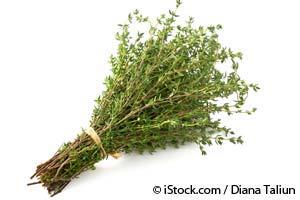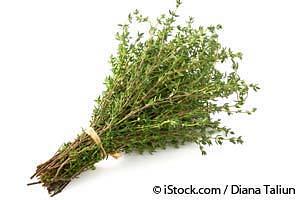Never Enough Thyme
Closely related to mint and oregano,
thyme is an evergreen herb that's had scores of uses over millennia,
stemming most often from adding zest to foods and as an ancient
medicinal. Traditional therapies often involved thyme in different forms to
relieve chest congestion and coughs. Greeks and Romans consumed it both
as an antidote for poison and to prevent the plague. In the Middle Ages, people placed thyme under pillows to inhibit
nightmares and in their baths to purify themselves for religious rites.
The Romans believed it could impart energy and valor, even sprinkling it
in cheese and alcohol to prevent the doldrums. In some early cultures, thyme was tucked in hats and pockets to help
overcome fear, prior to battle or asking a father for his daughter's
hand, and exchanged by Roman soldiers as a token of respect. That's how
thyme came to be associated with courage and bravery. As it turns out, there are good reasons for all these uses. Today,
clinical studies indicate there's a long list of highly effective uses
for health, including: Pain relief of cramps, headaches and body aches Inflammation Respiratory ailments Food contamination prevention and remediation Antibacterial and wound healer Depression Oral health Microbial and food preservative To explore the word's origins, we need to go back — literally — to its southern Mediterranean roots. The Oxford Dictionary says the Latin form of "thyme" was derived from
the Greek word "thumon," associated with the words "burn" and
"sacrifice." Then again, an ancient Greek form, "thumus," denotes
courage. The Old French "thym," circa the 1400s, is closer to the Middle
English pronunciation we use today. From Native American sacred herb-burning rituals called smudging to
the Greek and Roman tradition of leaving smoking bundles of thyme in
homes and temples for purification, this herb was close to every aspect
of life and death. Greeks believed its incense could ward off evil. In fact, one of its original meanings was "to fumigate." Egyptians, for whom the word "tham" meant "fragrant," used it for
mummification, completely unaware that thyme contains the compound
thymol, which has strong bactericidal and fungicidal properties. Regarding the purification rites that took place long before there
were any studies available, it's interesting that the Sumerians who
lived in the first Mesopotamian civilization in around 2700 B.C. used
thyme as an antiseptic. We'll probably never know how many of our ancestors' lives were saved
because, during the Black Death that swept through Europe, Scandinavia,
Asia and Africa in the mid-1300s, killing around 75 million, people
used thyme for both relief and protection. Garlands of thyme and other herbs were worn around the neck, and
poultices were effective for easing blisters. These measures must have
been effective. Clear through the Victorian era, nurses soaked used
cloth bandages in a solution of thyme, which disinfected them. Botanically, there are more than 400 types of Thymus vulgaris, but
few are suitable for culinary use. Most are ornamental, but they appear
very similar. Pleasantly fragrant thyme varieties for the kitchen are
French, caraway and lemon. One of the best aspects for herbal gardeners (if you'll pardon yet another pun) is that thyme literally takes care of itself. Other than removing dried leaves that may be nestling around it,
springtime demands only sunshine and nearly any amount of water for
perennial herbal bounty. Only when the soil is thoroughly dry do you
need to worry about giving it a good drink. At its seasonal peak, thyme has elongated teardrop-shaped leaves in
shades of olive, silvery green or even bronze. Left to themselves
(because you should harvest beforehand) they also bear a sprinkling of
tiny, delicate, pink, lavender or white blossoms. Gardeners love thyme for its ability to thrive between rocks and
flagstone, or in containers, creeping, climbing or spraying in lush
profusion. It grows quickly, so allow for that — 12 to 24 inches apart
is good — if you're setting it among other garden vegetables or herbs.
As the song goes, there's a time for everything. But no matter the
era or culture, health inevitably takes top priority for optimal quality
of life. That's why thyme and other herbs had a revered place in medicine troves from Native Americans to primordial Egyptians, Greeks and Romans. Although ancient civilizations may not have known why, thyme has a
powerful and diverse set of nutrients that explains its value in
treating and preventing disease. One study reported: "It was (shown) that the essential oil of thyme and the compound
thymol have antimicrobial activity in vitro against E. coli strains …
(and) also highlights the potential use of the essential oil of thyme as
a substitute for artificial inhibitors of food spoilage and pathogenic
microorganisms."1 Another study noted that thyme essential oil
and its compounds thymol and carvacrol were used as antimicrobial
agents that strongly inhibited Staphalococcus aureus and Bacillus
subtilis.2 A team of microbiologists published findings from another trial
revealing thyme's effectiveness on a MRSA superbug, which annihilated
the bacteria within two hours with no effect to surrounding skin.3 Reviews have also noted that herbal preparations of thyme
may be a more effective treatment for acne than prescription creams,
with greater antibacterial effect than benzoyl peroxide but, again,
without the skin irritation. Regarding the use of thyme to treat depression or Alzheimer's, a Science Daily study reported: "Apigenin, a substance found in parsley, thyme, chamomile and red
pepper, improves neuron formation and strengthens the connections
between brain cells, new lab research demonstrates … Apigenin works by binding to estrogen receptors, which affect the
development, maturation, function, and plasticity of the nervous
system. This group of hormones is known to delay the onset of psychiatric
and neurodegenerative disorders such as schizophrenia, depression,
Alzheimer's and Parkinson's disease."4 Nutritional attributes of thyme include impressive amounts of vitamin
C and K, as well as vitamin A, fiber, riboflavin, iron, copper and
manganese. You'll also find calcium, manganese, vitamin B6, folate,
phosphorus, potassium and zinc. You'll note several of those ingredients
as helpful for colds, sore throats and coughs. Germany's Commission E, a governmental agency that oversees the use
of herbs used for medicine, has approved the use of thyme for
respiratory tract infections, including whooping cough and bronchitis. In fact, the Swiss "herb drop" company at ricola.com5 has designated thyme as the "strongest" of its top 10 "magic" herbs. Here's one reason why: "Thymol, the main component of Thyme, is regarded as a very
effective disinfectant. This is presumably the reason why it is still
used to clean patients' rooms or old buildings. The bitters have an astringent action. Legend has it that this
harnesses strength and courage. The tannins additionally repair injured
mucous membrane, so that strengths are not drained." The site also reveals: "Renowned herbalist and pioneer of folk remedies, Pfarrer Künzle,
described the plant as follows, 'An excellent herb in teas to treat
stomach complaints and cleanse the lungs of mucous. Let the steam an
infusion of Thyme run through the ears and nasal passages to strengthen
the nerves of the ears, nose and brain and prevent fainting and strokes.
A compress of Thyme also helps you get a good night's sleep.'" A site dedicated to cancer prevention, called Eat to Beat Cancer,6 states: "The essential oils of thyme contain up to 54 [percent] thymol, a
natural phenol, which is very aromatic. Some thyme varieties have
hints of oregano because they also contain carvacrol which is the
essential oil of oregano. In addition to its pleasant aroma and
distinct flavor, thymol is a biocide, with antiseptic and medicinal
properties." Studies show that thyme increases the omega-3 fatty acid DHA
(docosahexaenoic acid) in the brains of animals in studies, which may
mean thyme can heighten brain function in the elderly as well as in children with attention deficit disorder. Eat to Beat Cancer adds: "Thyme is rich in anrtiangiogenic phenol content, including
apigenin, luteolin, eriodictyol, rosmarinic acid and quercetin. Luteolin
is the primary phenolic compound in thyme that confers anti-angiogenic
and anti-cancer properties. In an epidemiological study including over
66,000 women, women in the highest quintile of luteolin consumption were
found to have a 34 [percent] decrease in ovarian cancer incidence
compared to those in the lowest quintile. In laboratory studies, luteolin inhibited human ovarian cancer
cell proliferation and decreased the expression of the angiogenic growth
factor, VEGF. Other studies suggest this VEGF-inhibiting activity is
dependent on the particular aromatic ring structure of luteolin and
other similar phenolic compounds. In both skin cancer cells and mouse
models, luteolin inhibited ultraviolet radiation-induced skin cancers." Of course thyme is a versatile herb used all by itself or in
combination with other aromatic plants to enhance specific dishes.
Bouquet garni of French origin, for instance, is created by tying sprigs
of fresh thyme together with parsley and bay leaves for flavorful stews
and soup stock. Ground rosemary and fennel seeds combined with thyme, oregano,
marjoram, lavender, basil, parsley and tarragon make the classic Herbs
de Provence for savory fish, chicken, beef and pork dishes and roasted
vegetables. An easy salad dressing recipe featuring thyme is 1 tablespoon of freshly chopped thyme leaves with 3 tablespoons of extra-virgin olive oil,
1 tablespoon of white wine vinegar and a sprinkle of salt and pepper
over your greens. As a variation, 1 teaspoon of honey and 1 tablespoon
of Parmesan cheese adds extra dimension. You can also simply sprinkle it
in soups, scrambled eggs and sautéed vegetables for delicious variety. In fact, research shows it's a good idea to include thyme and other
herbs with antimicrobial constituents in your salads. One study7
reported that thyme essential oil decontaminated lettuce inoculated
with the infectious organism Shigella, which causes intestinal damage
and diarrhea. Researchers said even the low concentration of 1 percent lowered the
number of Shigella bacteria to undetectable levels, and concluded that
adding fresh thyme to dressing enhances the flavor but also allows you
to eat your fresh produce without worrying. How serendipitous is it that this herb can be more than just
attractive, but incorporated as part of your plan, like Hippocrates
said, to consider "food as your medicine and medicine as your food?" The
best part is that you can easily grow it yourself. Even if space is an issue, you can grow it in a container and set it in a window for fresh clippings or drying. Once it's established, there are a few different ways of "spreading
the love" of thyme, depending on your climate. These are best done in
the spring a few weeks after the last frost, or when the soil reaches
around 70 degrees.
From the Beginning: Thyme
Thymus Vulgaris: What Thyme Is It?
'A Thyme for Every Purpose Under Heaven'
It's About Thyme
Thyme in a Bottle for Culinary Diversity
Saving Thyme — Otherwise Known as Propagation
Read More..
Comments
There are 0 comments on this post













